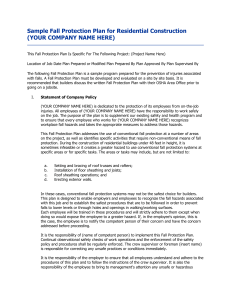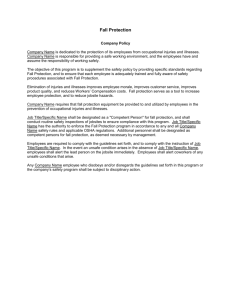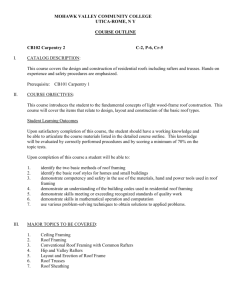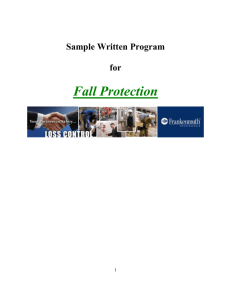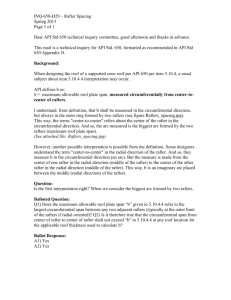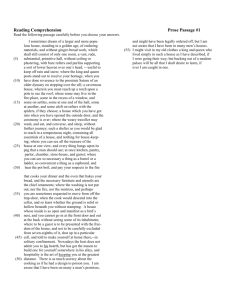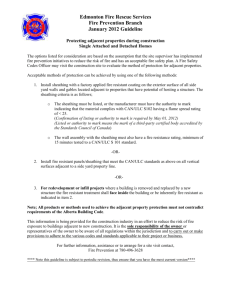sample fall protection plan for residential construction
advertisement
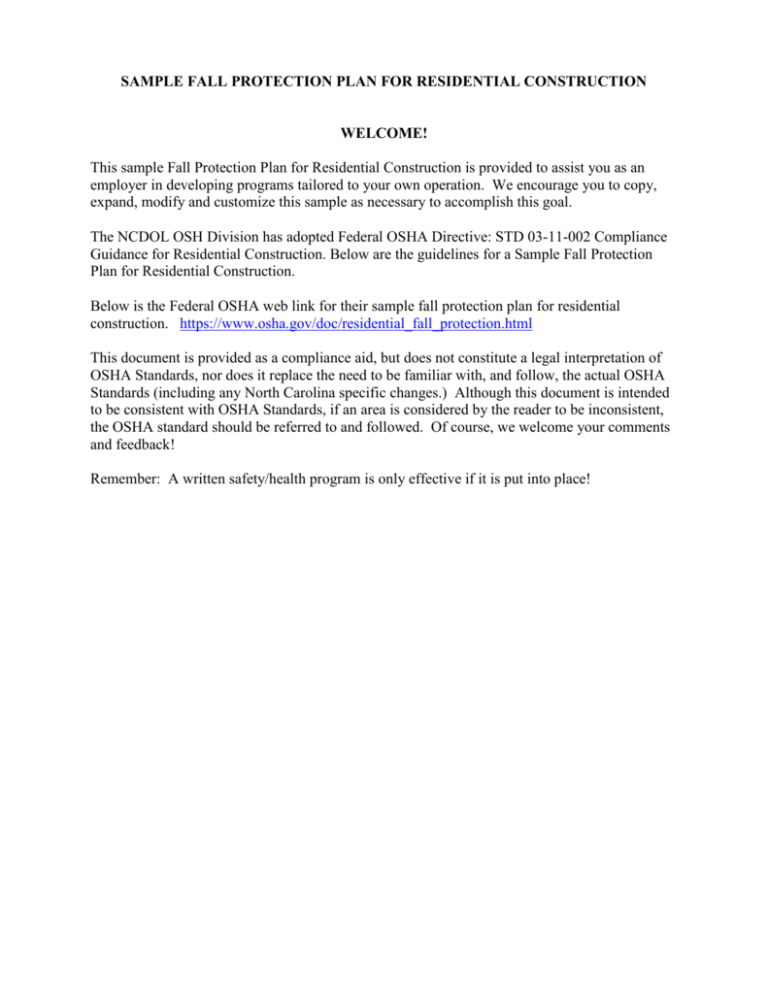
SAMPLE FALL PROTECTION PLAN FOR RESIDENTIAL CONSTRUCTION WELCOME! This sample Fall Protection Plan for Residential Construction is provided to assist you as an employer in developing programs tailored to your own operation. We encourage you to copy, expand, modify and customize this sample as necessary to accomplish this goal. The NCDOL OSH Division has adopted Federal OSHA Directive: STD 03-11-002 Compliance Guidance for Residential Construction. Below are the guidelines for a Sample Fall Protection Plan for Residential Construction. Below is the Federal OSHA web link for their sample fall protection plan for residential construction. https://www.osha.gov/doc/residential_fall_protection.html This document is provided as a compliance aid, but does not constitute a legal interpretation of OSHA Standards, nor does it replace the need to be familiar with, and follow, the actual OSHA Standards (including any North Carolina specific changes.) Although this document is intended to be consistent with OSHA Standards, if an area is considered by the reader to be inconsistent, the OSHA standard should be referred to and followed. Of course, we welcome your comments and feedback! Remember: A written safety/health program is only effective if it is put into place! SAMPLE FALL PROTECTION PLAN FOR RESIDENTIAL CONSTRUCTION __________________________________________________________ (Company Name) THIS FALL PROTECTION PLAN IS SPECIFIC FOR THE FOLLOWING PROJECT: Location of Job ___________________________________________________ Date Plan Prepared or Modified ______________________________________ Plan Prepared By __________________________________________________ Plan Approved By _________________________________________________ Plan Supervised By ________________________________________________ The following Fall Protection Plan is a sample program prepared for the prevention of injuries associated with falls. A Fall Protection Plan must be developed and evaluated on a site by site basis. It is recommended that builders discuss the written Fall Protection Plan with NCDOLOSH at 1-800-NCLABOR prior to going on a jobsite. I. STATEMENT OF COMPANY POLICY. _______________________________________ (your company name) is dedicated to the protection of its employees from on-the-job injuries. All employees of ____________________________ (your company name) have the responsibility to work safely on the job. The purpose of the plan is to supplement our existing safety and health program and to ensure that every employee who works for ___________________ (your company name) recognizes workplace fall hazards and takes the appropriate measures to address those hazards. This Fall Protection Plan addresses the use of conventional fall protection at a number of areas on the project, as well as identifies specific activities that require non-conventional means of fall protection. During the construction of residential buildings under 48 feet in height, it is sometimes infeasible or it creates a greater hazard to use conventional fall protection systems at specific areas of for specific tasks. The areas or tasks may include, but are not limited to: a. b. c. d. Setting and bracing of roof trusses and rafters; Installation of floor sheathing and joists; Roof sheathing operations; and Erecting exterior walls. In these cases, conventional fall protection systems may not be the safest choice for builders. This plan is designed to enable employers and employees to recognize the fall hazards associated with this job and to establish the safest procedures that are to be followed in order to prevent falls to lower levels or through holes and openings in walking/working surfaces. 2 Each employee will be trained in these procedures and will strictly adhere to them except when doing so would expose the employee to a greater hazard. If, in the employee’s opinion, this is the case, the employee is to notify the competent person of their concern and have the concern addressed before proceeding. It is the responsibility of _________________________________ (your company name) to implement this Fall Protection Plan. Continual observational safety checks of work operations and the enforcement of the safety policy and procedures shall be regularly enforced. The crew supervisor or foreman __________________________ (insert name) is responsible for correcting any unsafe practices or conditions immediately. It is the responsibility of the employer to ensure that all employees understand and adhere to the procedures of this plan and to follow the instructions of the crew supervisor. It is also the responsibility of the employee to bring to management’s attention any unsafe or hazardous conditions or practices that may cause injury to either themselves or any other employees. Any changes to the Fall Protection Plan must be approved by _____________________________ (name of qualified person). II. FALL PROTECTION SYSTEMS TO BE USED ON THIS JOB Installation of roof trusses/rafters, exterior wall erection, roof sheathing, floor sheathing and joist/truss activities will be conducted by employees who are specifically trained to do this type of work and are trained to recognize the fall hazards. The nature of such work normally exposes the employee to the fall hazard for a short period of time. This plan details how _____________ ________________________(your company name) will minimize these hazards. Controlled Access Zones When using the Plan to implement the fall protection options available, workers must be protected through limited access to high hazard locations. Before any non-conventional fall protection systems are used as part of the work plan, a controlled access zone (CAZ) shall be clearly defined by the competent person as an area where a recognized hazard exists. The demarcation of the CAZ shall be communicated by the competent person in an recognized manner, either through signs, wires, tapes, ropes or chains. ____________________________ (your company name) shall take the following steps to ensure that the CAZ is clearly marked or controlled by the competent person: All access to the CAZ must be restricted to authorized entrants; All workers who are permitted in the CAZ shall be listed in the appropriate sections of the Plan (or be visibly identifiable by the competent person) prior to implementation; The competent person shall ensure that all protective elements of the CAZ be implemented prior to the beginning of work. 3 Installation Procedures for Roof/Truss and Rafter Erection During the erection and bracing of roof trusses/rafters, conventional fall protection may present a greater hazard to workers. On this job, safety nets, guardrails and personal fall arrest systems will not provide adequate fall protection because the nets cause the walls to collapse, while there are not suitable attachment or anchorage points for guardrails or personal fall arrest systems. On this job, requiring workers to use a ladder for the entire installation process will cause a greater hazard because the worker must stand on the ladder with his back or side to the front of the ladder. White erecting the truss or rafter the worker will need both hands to maneuver the truss and therefore cannot hold onto the ladder. In addition, ladders cannot be adequately protected from movement while trusses are being maneuvered into place. Many workers may experience additional fatigue because of the increase in overhead work with heavy materials, which can also lead to a greater hazard. Exterior scaffolds cannot be utilized on this job because the ground, after recent backfilling, cannot support the scaffolding. In most cases, the erection and dismantling of the scaffold would expose workers to a greater fall hazard than erection of the trusses/rafters. On all walls eight feet or less, worker will install interior scaffolds along the interior wall below the location where the trusses/rafters will be erected. “Sawhorse” scaffolds constructed of 46 inch sawhorses and 2x10 planks will often allow workers to be elevated high enough to allow for the erection of trusses and rafters without working on the top plate of the wall. In structures that have walls higher than eight feet and where the use of scaffolds and ladders would create a greater hazard, safe working procedures will be utilized when working on the top plate and will be monitored by the crew supervisor. During all stages of truss/rafter erection the stability of the trusses/rafters will be ensured at all times. ________________________________ (your company name) shall take the following steps to protect workers who are exposed to fall hazards while working from the top plate installing trusses/rafters. Only the following trained workers will be allowed to work on the top plate during roof truss or rafter installation: __________________________________________________________________ __________________________________________________________________ __________________________________________________________________ Workers shall have no other duties to perform during truss/rafter erection procedures; All trusses/rafters will be adequately braced before any worker can use the truss/rafter as a support; 4 Workers will remain on the top plate using the previously stabilized truss/rafter as a support while other trusses/rafters are being erected; Workers will leave the area of the secured trusses only when it is necessary to secure another truss/rafter; The first two trusses/rafters will be set from ladders leaning on side walls at points where the walls can support the weight of the ladder; and A worker will climb onto the interior top plate via a ladder to secure the peaks of the first two trusses/rafters being set. The workers responsible for detaching trusses from cranes and/or securing trusses at the peaks traditionally are positioned at the peak of the trusses/rafters. There are also situations where workers securing rafters to ridge beams will be positioned on top of the ridge beam. _____________________________________ (your company name) shall take the following steps to protect workers who are exposed to fall hazards while securing trusses/rafters at the peak of the trusses/ridge beam. Only the following trained workers will be allowed to work at the peak during roof truss or rafter installation: __________________________________________________________________ __________________________________________________________________ __________________________________________________________________ Once truss or rafter installation begins, workers not involved in that activity shall not stand or walk below or adjacent to the roof opening or exterior walls in any area where they could be struck by falling objects; Workers shall have no other duties than securing/bracing the trusses/ridge beam; Workers positioned at the peaks or in the webs of trusses or on top of the ridge beam shall work from a stable position, either by sitting on a “ridge seat” or other equivalent surface that provides additional stability or by positioning themselves in previously stabilized trusses/rafters and leaning into and reaching through the trusses/rafters; Workers shall not remain on or in the peak/ridge any longer than necessary to safely complete the task. Roof Sheathing Operations Workers typically install roof sheathing after all trusses/rafters and any permanent truss bracing is in place. Roof structures are unstable until some sheathing is installed, so workers installing roof sheathing cannot be protected from fall hazards by conventional fall protection systems until it is determined that the roofing system can be used as an 5 anchorage point. At that point, employees shall be protected by a personal fall arrest system. Trusses/rafters are subject to collapse if a worker falls while attached to a single truss with a belt/harness. Nets could also cause collapse, and there is no place to attach guardrails. All workers will ensure that they have secure footing before they attempt to walk on the sheathing, including cleaning shoes/boots of mud or other slip hazards. To minimize the time workers must be exposed to a fall hazard, materials will be staged to allow for the quickest installation of sheathing. __________________________________ (your company name) shall take the following steps to protect workers who are exposed to fall hazards while installing roof sheathing: Once roof sheathing installation begins, workers not involved in the activity shall not stand or walk below or adjacent to the roof opening or exterior walls in any area where they could be struck by falling objects; The competent person shall determine the limits of this area, which shall be clearly communicated to workers prior to placement of the first piece of roof sheathing; The competent person may order work on the roof to be suspended for brief periods as necessary to allow other workers to pass through such area when this would not create a greater hazard; Only qualified workers shall install roof sheathing; The bottom row of roof sheathing may be installed by workers standing in truss webs; After the bottom row of roof sheathing is installed, a slide guard extending the width of the roof shall be securely attached to the roof. Slide guards are to be constructed of no less than nominal 4" height capable of limiting the uncontrolled slide of workers. Workers should install the slide guard standing in truss webs and leaning over the sheathing; Additional rows of roof sheathing may be installed by workers positioned on previously installed rows of sheathing. A slide guard can be used to assist workers in retaining their footing during successive sheathing operations; and Additional slide guards shall be securely attached to the roof at intervals not to exceed 13 feet as successive rows of sheathing are installed. For roofs with pitches in excess of 9-in-12, slide guards will be installed at four-foot intervals. 6 When wet weather (rain, snow, or sleet) are present, roof sheathing operations shall be suspended unless safe footing can be assured for those workers installing sheathing. When strong winds (above 40 miles per hour) are present, roof sheathing operations are to be suspended unless wind breakers are erected. Installation of Floor Joists and Sheathing During the installation of floor sheathing/joists (leading edge construction), the following steps shall be taken to protect workers: Only the following trained workers will be allowed to install floor joists or sheathing: _____________________________________ _____________________________________ _____________________________________ Materials for the operations shall be conveniently staged to allow for easy access to workers; The first floor joists or trusses will be rolled into position and secured either from the ground, ladders or sawhorse scaffolds; Each successive floor joist or truss will be rolled into place and secured from a platform created from a sheet of plywood laid over the previously secured floor joists or trusses; Except for the first row of sheathing which will be installed from ladders or the ground, workers shall work from the established deck; and Any workers not assisting in the leading edge construction while leading edges still exist (e.g. cutting the decking from the installers) shall not be permitted within six feet of the leading edge under construction. Erection of Exterior Walls During the construction and erection of exterior walls, employers shall take the following steps to protect workers: Only the flowing trained workers will be allowed to erect exterior walls; _________________________________________ _________________________________________ _________________________________________ A painted line six feet from the perimeter will be clearly marked prior to any wall erection activities to warn of the approaching edge; Materials for operations shall be conveniently staged to minimize fall hazards; and Workers constructing exterior walls shall complete as much cutting of materials and other preparation as possible away from the edge of the deck. 7 III. ENFORCEMENT Constant awareness of and respect for fall hazards, and compliance with all safety rules are considered conditions of employment. The crew supervisor or foreman, as well as individuals in the Safety and Personnel Department, reserve the right to issue disciplinary warnings to employees, up to and including termination, for failure to follow the guidelines of this program. IV. ACCIDENT INVESTIGATIONS All accidents that result in injury to workers, regardless of their nature, shall be investigated and reported. It is an integral part of any safety program that documentation take place as soon as possible so that the cause and means of prevention can be identified to prevent a reoccurrence. In the event that an employee falls or there is some other related, serious incident occurring, this plan shall be reviewed to determine if additional practices, procedures, or training need to be implemented to prevent similar types of falls or incidents from occurring. V. CHANGES TO PLAN Any changes to the plan will be approved by __________________________ (name of qualified person). This plan shall be reviewed by a qualified person as the job progresses to determine if additional practices, procedures or training needs to be implemented by the competent person to improve or provide additional fall protection. Workers shall be notified and trained, if necessary, in the new procedures. A copy of this plan and all approved changers shall be maintained at the jobsite. Revised 10/01/2013 8
